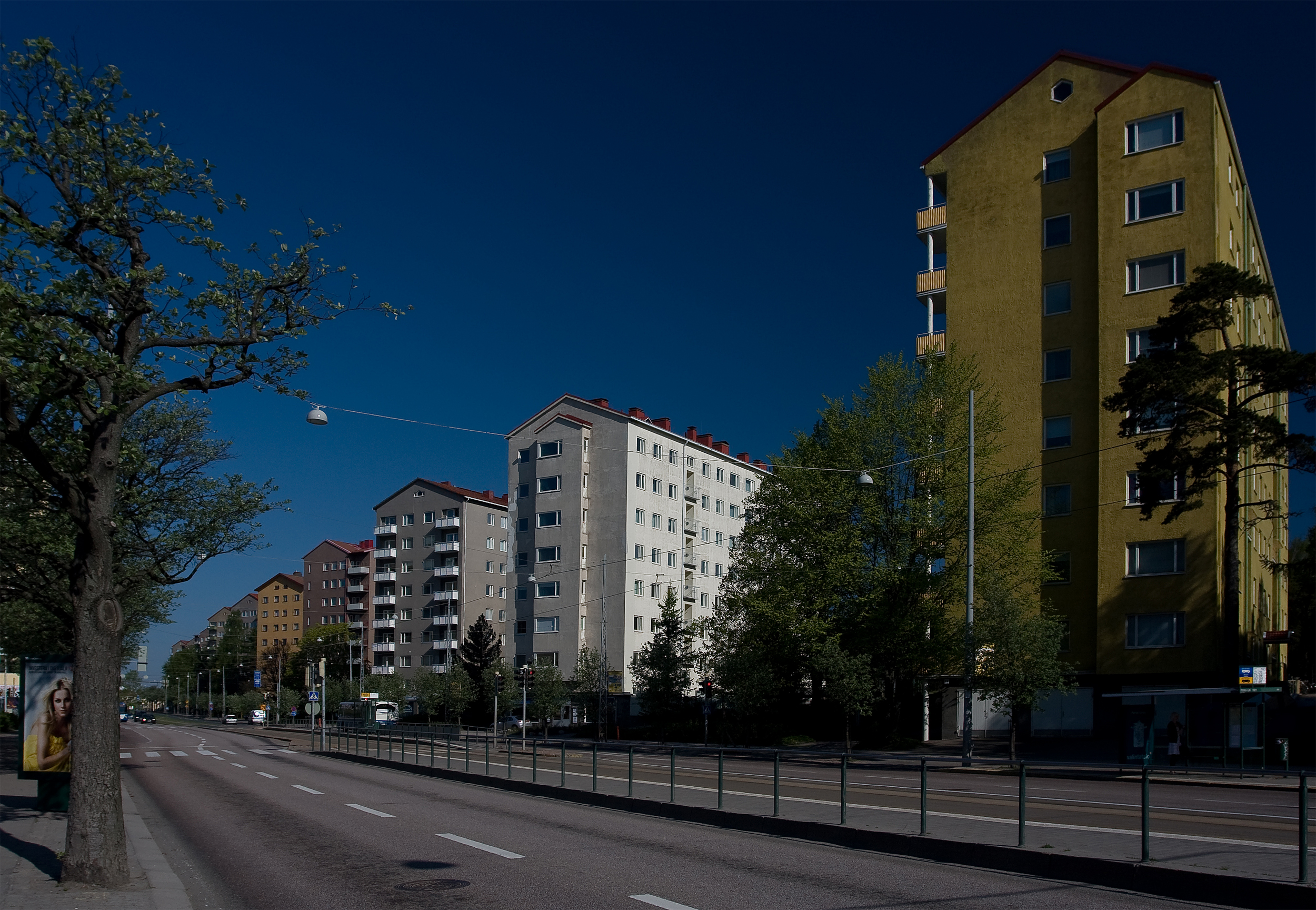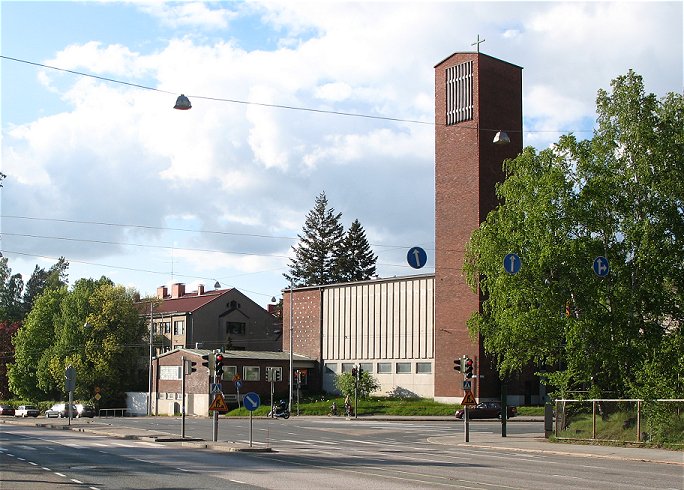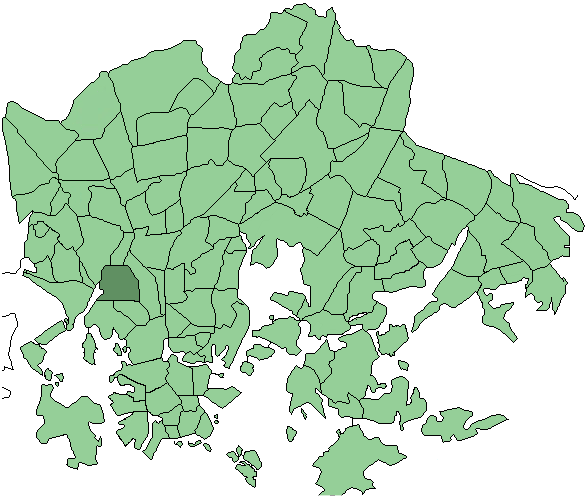|
Mannerheimintie
Mannerheimintie ( sv, Mannerheimvägen), named after the Finnish military leader and statesman Carl Gustaf Emil Mannerheim, is the main street and boulevard of Helsinki, Finland. It was originally named Heikinkatu ( sv, Henriksgatan), after Robert Henrik Rehbinder, but was renamed after the Winter War. The change of name was also suitable due to Mannerheim having paraded in along that road during the Finnish Civil War (1918), after German forces allied with Mannerheim's Finnish forces had retaken the city. That event is also portrayed in the landmark statue of Mannerheim sitting horseback. The statue is located along the Mannerheimintie just outside the modern arts museum Kiasma. The street starts at Erottaja in the city centre, near the Swedish Theatre and continues in a northernly direction past the Stockmann department store. It then continues as a main thoroughfare past the districts of Kamppi, Töölö, Meilahti, Laakso and Ruskeasuo, until it finally merges into ... [...More Info...] [...Related Items...] OR: [Wikipedia] [Google] [Baidu] |
Laakso
Laakso ( sv, Dal) is a neighbourhood in Helsinki, Finland. Its borders are defined by the streets of Mannerheimintie and Nordenskiöldinkatu and the Helsinki Central Park. The neighbourhood is bordered by Töölö in the south, Meilahti in the southwest, Ruskeasuo in the north and Länsi-Pasila in the east. The neighbourhood has an area of 0.74 km², a population of 1781 and 1583 jobs (December 31, 2003). Laakso is neighbourhood #18 in the official neighbourhood numbering of Helsinki, and belongs to the district of Reijola. The population in Laakso is mainly concentrated in multiple-floor apartment buildings on Mannerheimintie. The neighbourhood also includes a hospital, a riding field, a traffic playground, and a large part of the southern Central Park. For the 1952 Summer Olympics The 1952 Summer Olympics ( fi, Kesäolympialaiset 1952; sv, Olympiska sommarspelen 1952), officially known as the Games of the XV Olympiad ( fi, XV olympiadin kisat; sv, Den XV ... [...More Info...] [...Related Items...] OR: [Wikipedia] [Google] [Baidu] |
Stockmann, Helsinki Centre
Stockmann Helsinki Centre is a culturally significant business building and department store located in the centre of Helsinki, Finland. It is one of many department stores owned by the Stockmann corporation. It is the largest department store in the Nordic countries in terms of area and total sales. The store is known for carrying all the internationally recognised luxury brands, and Stockmann's enjoys a reputation as the primary high-end department store in Finland. Stockmann Delicatessen, the food and beverage department located at the basement level, is renowned for the quality and choice of its foodstuffs. The Stockmann logo represents a set of escalators, which are commonly, but wrongly believed represent the first escalators in Finland. The first escalators in Finland were installed in the Forum department store, Turku (1926). In 2017, Stockmann Helsinki Centre was the fifth largest department store in Europe with area of 50,500 square meters. Especially the clock at the ... [...More Info...] [...Related Items...] OR: [Wikipedia] [Google] [Baidu] |
Carl Gustaf Emil Mannerheim
Baron Carl Gustaf Emil Mannerheim (, ; 4 June 1867 – 27 January 1951) was a Finnish military leader and statesman. He served as the military leader of the Whites in the Finnish Civil War of 1918, as Regent of Finland (1918–1919), as commander-in-chief of Finland's defence forces during the period of World War II (1939–1945), as Marshal of Finland (1942–), and as the sixth president of Finland (1944–1946). The Russian Empire dominated the Grand Duchy of Finland before 1917, and Mannerheim made a career in the Imperial Russian Army, rising by 1917 to the rank of lieutenant general. He had a prominent place in the ceremonies for Emperor Nicholas II's coronation in 1896 and later had several private meetings with the Tsar. After the Bolshevik revolution of November 1917 in Russia, Finland declared its independence (6 December 1917) – but soon became embroiled in the 1918 Finnish Civil War between the pro-Bolshevik "Reds" and the "Whites", who were the troop ... [...More Info...] [...Related Items...] OR: [Wikipedia] [Google] [Baidu] |
Meilahti
Meilahti (in Swedish Mejlans) is a neighbourhood of Helsinki between Mannerheimintie (the main entrance road to Helsinki) and a bay named Seurasaarenselkä. Most of the houses in Meilahti were built in the 1930s and 1940s. Meilahti is home to over 6700 people. Meilahti is the location of Mäntyniemi, official residence of the President of Finland, as well as Kesäranta, the official residence of Prime Minister of Finland. Near Mäntyniemi is the former presidential residence, Tamminiemi, which is today a museum dedicated to president Urho Kekkonen. Several hospitals are located in this district, including the Meilahti Hospital of the Helsinki University Central Hospital (HUCH). Neighbourhoods surrounding Meilahti are Töölö, Munkkiniemi, Ruskeasuo, Pikku Huopalahti and Laakso. For the 1952 Summer Olympics The 1952 Summer Olympics ( fi, Kesäolympialaiset 1952; sv, Olympiska sommarspelen 1952), officially known as the Games of the XV Olympiad ( fi, XV olympiadi ... [...More Info...] [...Related Items...] OR: [Wikipedia] [Google] [Baidu] |
Erottaja
Erottaja ( sv, Skillnaden), meaning "the separator", is a public square near the centre of Helsinki, Finland. Erottaja square has been selected as the official geographic " zero point" of Helsinki. Distances to all other cities in Finland are measured starting from here. In practice, the square functions as the meeting point of central Helsinki's two famous streets, Esplanadi and Mannerheimintie. The square is the western endpoint of Esplanadi, with the eastern endpoint being at the market square. Mannerheimintie, the longest and most famous street in Helsinki, begins at Erottaja and continues northwest, past the districts of Töölö and Ruskeasuo, until finally merging with a highway leading outside the city. The starting points of both Finnish national roads, the Tampere Highway ( E12) and the Lahti Highway ( E75), are located approximately in Erottaja. There is also a minor bus station at Erottaja. Very few lines start or end there, most of them start or end at the Kamppi Cen ... [...More Info...] [...Related Items...] OR: [Wikipedia] [Google] [Baidu] |
Eduskuntatalo
The Parliament House ( fi, Eduskuntatalo, sv, Riksdagshuset) is the seat of the Parliament of Finland. It is located in the Finland, Finnish capital Helsinki, in the district of Töölö. History In 1923 a competition was held to choose a site for a new parliament house. Arkadianmäki, a hill beside what is now Mannerheimintie, was chosen as the best site. The architectural competition which was held in 1924 was won by the firm of Borg–Sirén–Åberg with a proposal called Oratoribus (Latin language, Latin for "for the speakers"). Johan Sigfrid Sirén (1889–1961), who was mainly responsible for preparing the proposal, was given the task of designing Parliament House. The building was constructed 1926–1931 and was officially inaugurated on March 7, 1931. Ever since then, and especially during the Winter War and Continuation War, it has been the scene of many key moments in the nation's political life. Architecture and features Sirén designed Parliament House in a Strip ... [...More Info...] [...Related Items...] OR: [Wikipedia] [Google] [Baidu] |
Boulevard
A boulevard is a type of broad avenue planted with rows of trees, or in parts of North America, any urban highway. Boulevards were originally circumferential roads following the line of former city walls. In American usage, boulevards may be wide, multi-lane arterial thoroughfares, often divided with a central median, and perhaps with side-streets along each side designed as slow travel and parking lanes and for bicycle and pedestrian usage, often with an above-average quality of landscaping and scenery. Etymology The word ''boulevard'' is borrowed from French. In French, it originally meant the flat surface of a rampart, and later a promenade taking the place of a demolished fortification. It is a borrowing from the Dutch word ' 'bulwark'. Usage world-wide Asia Cambodia Phnom Penh has numerous boulevards scattered throughout the city. Norodom Boulevard, Monivong Boulevard, Sihanouk Boulevard, and Kampuchea Krom Boulevard are the most famous. India *Bengaluru's Mah ... [...More Info...] [...Related Items...] OR: [Wikipedia] [Google] [Baidu] |
Helsinki
Helsinki ( or ; ; sv, Helsingfors, ) is the Capital city, capital, primate city, primate, and List of cities and towns in Finland, most populous city of Finland. Located on the shore of the Gulf of Finland, it is the seat of the region of Uusimaa in southern Finland, and has a population of . The Helsinki urban area, city's urban area has a population of , making it by far the List of urban areas in Finland by population, most populous urban area in Finland as well as the country's most important center for politics, education, finance, culture, and research; while Tampere in the Pirkanmaa region, located to the north from Helsinki, is the second largest urban area in Finland. Helsinki is located north of Tallinn, Estonia, east of Stockholm, Sweden, and west of Saint Petersburg, Russia. It has History of Helsinki, close historical ties with these three cities. Together with the cities of Espoo, Vantaa, and Kauniainen (and surrounding commuter towns, including the eastern ... [...More Info...] [...Related Items...] OR: [Wikipedia] [Google] [Baidu] |
Ruskeasuo
Ruskeasuo (Brunakärr in Swedish, verbatim "Brown swamp") is a neighbourhood of Helsinki (Helsingfors in Swedish), about 3 kilometres north of the city center. With a population of 2670 (year 2005) Ruskeasuo is a rather quiet residential area. Buildings by Mannerheimintie are typically 6-8 floors high from 1950s. Between Mannerheimintie and Central Park, low-rise buildings are dominant. The equestrian dressage and eventing competitions for the 1952 Summer Olympics The 1952 Summer Olympics ( fi, Kesäolympialaiset 1952; sv, Olympiska sommarspelen 1952), officially known as the Games of the XV Olympiad ( fi, XV olympiadin kisat; sv, Den XV olympiadens spel) and commonly known as Helsinki 1952 ( sv, Helsin ... took place at their sports hall. References1952 Summer Olympics official report.p. 58. Venues of the 1952 Summer Olympics Olympic equestrian venues {{Summer-Olympic-venue-stub ... [...More Info...] [...Related Items...] OR: [Wikipedia] [Google] [Baidu] |
Robert Henrik Rehbinder
Count Robert Henrik Rehbinder (15 July 1777 – 8 March 1841) served as the Secretary of State for the Grand Duchy of Finland between 1811 and 1841. One of the highest officials in the Grand Duchy, he played a significant part in establishing the autonomous role of Finland at the Diet of Porvoo in 1809. Biography Born in Paimio, Rehbinder was given the title count in 1826, and in 1834 he was given the title Privy Counsellor. He was also awarded with the second highest Russian honor and given an honorary doctorship in philosophy at the University of Helsinki in 1840, at the 200 year jubilee of the University (originally Royal Academy of Turku). He also owned the ''Viksberg castle'' in Paimio. He died in Saint Petersburg. Three streets in Helsinki have been named after him: ''Stora Robertsgatan'' ('' Iso Roobertinkatu'') in Punavuori, ''Lilla Robertsgatan'' (''Pieni Roobertinkatu'') in Kaartinkaupunki and ''Rehbindersvägen'' (''Rehbinderintie'') in Eira. Furthermore, the curren ... [...More Info...] [...Related Items...] OR: [Wikipedia] [Google] [Baidu] |
Hotel Marski
Hotel Marski (or Marski by Scandic) is a hotel opened 1962 on Mannerheimintie 10 in Helsinki, Finland. The hotel was built by Alko-owned Arctia Oy and the nine-storey building with strip windows was designed in 1961 by architect Einari Teräsvirta. The hotel was housed in a residential building built in 1877 by Nikolai Kiseleff and designed by F. A. Sjöström.Hotelli Marskin talo; Mannerheimintie 10. Lönnrotinkatu 1; Helsinki - Helsingin Kaupunginmuseo (in Finnish) The name Marski (as well as the street name along which the hotel is located) refers to . Hotel Marski was open ... [...More Info...] [...Related Items...] OR: [Wikipedia] [Google] [Baidu] |
Tampere Highway
Finnish national road 3 ( fi, Valtatie 3 or '; sv, Riksväg 3) is a highway in Finland between Helsinki and Vaasa via Hämeenlinna and Tampere. The road is long and it is part of the European route E12. of the highway is motorway, connecting Helsinki to Tampere. North of Tampere, the road is mostly two-lane road, with a share of 2+1 road. The busiest point on Highway 3 is in Helsinki, north of the Ring I junction, where the average traffic volume is about 90,000 vehicles per day. Back in the late 1950s before the current freeway, the Finnish regional road 132 (Mt 132) was the former main road to Hämeenlinna and Tampere via Loppi and Janakkala. Route The route of the road is: Helsinki – Vantaa – Nurmijärvi – Hyvinkää – Riihimäki – Janakkala – Hämeenlinna – Hattula – Kalvola – Valkeakoski – Akaa – Valkeakoski (again) – Lempäälä – Tampere – Pirkkala – Nokia – Tampere (again) – Ylöjärvi – Hämeenkyrö – ... [...More Info...] [...Related Items...] OR: [Wikipedia] [Google] [Baidu] |
.jpg)







